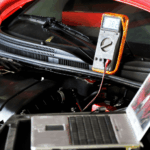Safety is extremely important in our vehicles, and the NHTSA has implemented stricter regulations for Automatic Emergency Braking (AEB) systems.
Increased safety in our vehicles is necessary. Too many lives are lost in vehicular crashes each year. Many of these lives could have been saved if the vehicles in the collision had been equipped with AEB systems that would have completely prevented the crash. The NHTSA finalized stricter regulations for these systems, and by 2029, all cars sold in the United States must meet these new standards. With the increased number of vehicles on the road, safety systems must become much better.
What do these updated regulations call for?
The increased rules for the AEB system require them to function at higher speeds. These speeds could be as high as 90 mph, which makes sense because most drivers are traveling above the posted speed limit. The AEB systems must also work during nighttime driving using nothing more than low-beam headlights.
In addition to the low-beam requirement, the NHTSA has implemented a new “no contact” performance requirement demand on the AEB system to fully prevent collisions when a vehicle is traveling up to 62 mph for cars traveling toward other cars and 45 mph for pedestrians.
These new regulations put a much stricter requirement on OEMs that will need to pass a series of tests to demonstrate their vehicles are in compliance with them.
Are current AEB systems ready for these tests?
The current Automatic Emergency Braking systems are woefully behind the proverbial eight-ball in terms of performance with these new regulations. Only one in 13 models from the 2023 model year passed these new regulations in preliminary NHTSA testing. Those that did pass engaged harsh braking, which is extremely uncomfortable for passengers and can be potentially dangerous at higher speeds.
Putting some numbers to it
During similar testing conducted by the IIHS, very few vehicles passed the tests. The IIHS tested the AEB systems of 194 vehicles from the 2023 model year. These tests showed that only 33 models fully avoided the pedestrian mannequin in every test, and only 12 were capable of avoiding the mannequin during night testing.
As you can see, most vehicles will require some significant upgrades to their AEB systems in order to meet the new regulations prior to the 2029 deadline.
The world of unintended consequences
As you might expect, the automotive industry is pushing back on these new Automatic Emergency Braking standards. One area in which OEMs forecast an issue is the “no contact” with the lead vehicle at higher speeds. If the systems are programmed to detect potential collisions and take evasive actions, there would be an increase in the number of false positive AEB engagements. Current AEB systems already do this, especially when a vehicle moves into a turn lane and slows down, making it difficult to feel comfortable with the system. The increased number of false positives could increase the number of rear-end collisions from vehicles without these new advanced systems.
Increased costs could be a serious problem
The average price of new vehicles has steadily increased. With that figure already dangerously close to $50,000, added technology and improved systems will certainly push these costs further. OEMs have argued that increased costs could require each automaker to spend an average of $430 million to update the AEB systems to meet the new standard. This is much more than the NHTSA’s initial estimate of $354 million across the industry. These increased costs would certainly be passed on to the consumer, which pushes the average vehicle cost even higher.
How can OEMs balance cost with reliability?
The balance of equipment that can be relatively cost-effective while meeting the new requirements is a serious challenge for automakers. They will have to choose which sensors to integrate to meet these stricter requirements while balancing the cost and reliability of the systems. The sensors currently available are cameras, Lidar, Infrared cameras, and radar systems. Each has its own benefits, but with those benefits also comes the cost that would be added to each vehicle.
For most OEMs, the pathway forward to meet the new Automatic Emergency Braking regulations will be a combination of systems using radar and camera to balance the performance and costs of these upgraded systems. Many automakers currently utilize radar and camera systems in new vehicles, which makes upgrading these sensors would be more economical than adding an entirely new system. Cameras are most effective during daytime driving, and radar offers the desired long-range, all-weather performance.
The new AEB regulations implemented by the NHTSA is another step toward keeping drivers safer on the road, but are these advancements worth the cost? Only time will give us the answer to that question.







Leave a Reply